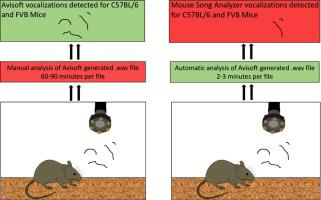Journal of Neuroscience Methods ( IF 2.7 ) Pub Date : 2020-08-14 , DOI: 10.1016/j.jneumeth.2020.108913 Matthew Binder 1 , Suzanne O Nolan 2 , Joaquin N Lugo 3

|
Background
Communicative behaviors play a vital role in mammals and are highly relevant to human neurodevelopmental conditions. Mice produce communicative vocalizations that occur in the ultrasonic range, which are commonly analyzed within the Avisoft recording system. Fully automated programs such as the Mouse Song Analyzer in MATLAB, have been developed to analyze USVs in a shorter time period, however, no study has compared the accuracy of MATLAB to Avisoft.
New Method
In order to determine MATLAB’s accuracy, we used data from four different mouse strains and assessed whether the total number of USVs detected was similar between systems.
Results
We found that there was a high correlation between systems for the number of USVs emitted from C57BL/6 and NS-Pten mice however, Avisoft detected significantly more USVs than MATLAB for both strains. For Fmr1-FVB.129 and 129 mice, large correlations were observed between systems and no significant difference was present in the USVs detected. A partial correlation was run to control for the covariates: sex, age, strain, and treatment, and found that only strain substantially influences the relationship between the USVs detected in Avisoft and those detected in MATLAB.
Comparison with Existing Method
These findings demonstrate that there is a high degree of agreement between Avisoft and the Mouse Song Analyzer however, Avisoft does detect significantly more USVs depending on the strain assessed.
Conclusions
Therefore, there are relative advantages and disadvantages with both systems that vocalization researchers should be aware of when interpreting USV results, and when using either system.
中文翻译:

Avisoft (v.5.2) 和 MATLAB Mouse Song Analyzer (v.1.3) 发声分析系统在 C57BL/6、Fmr1-FVB.129、NS-Pten-FVB 和 129 只小鼠中的比较。
背景
交流行为在哺乳动物中起着至关重要的作用,并且与人类的神经发育状况高度相关。小鼠产生发生在超声波范围内的交流发声,通常在 Avisoft 录音系统中进行分析。MATLAB 中的 Mouse Song Analyzer 等全自动程序已开发用于在更短的时间内分析 USV,但是,没有研究将 MATLAB 的准确性与 Avisoft 进行比较。
新方法
为了确定 MATLAB 的准确性,我们使用了来自四种不同小鼠品系的数据,并评估了系统之间检测到的 USV 总数是否相似。
结果
我们发现系统与 C57BL/6 和 NS- Pten小鼠发射的 USV 数量之间存在高度相关性,但是,对于这两种菌株,Avisoft 检测到的 USV 明显多于 MATLAB。对于Fmr1- FVB.129 和 129 小鼠,在系统之间观察到很大的相关性,并且在检测到的 USV 中不存在显着差异。运行偏相关以控制协变量:性别、年龄、应变和治疗,并发现只有应变才能显着影响 Avisoft 中检测到的 USV 与 MATLAB 中检测到的 USV 之间的关系。
与现有方法的比较
这些发现表明 Avisoft 和 Mouse Song Analyzer 之间存在高度一致,但是,根据评估的应变,Avisoft 确实检测到明显更多的 USV。
结论
因此,在解释 USV 结果和使用任一系统时,发声研究人员应该注意这两种系统的相对优点和缺点。







































 京公网安备 11010802027423号
京公网安备 11010802027423号